 |
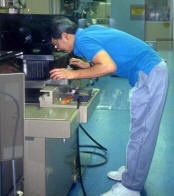 |
| Difficult to see because of poor height or orientation | |
Principles affected
Related pages
Workstations:
- Lighting
- Magnification
- as indicated in related topics below.
Background
A surprisingly common problem is that employees simply cannot see what they need to see. Causes include:
- Unsuitable height, location, and orientation for the product and task
- Incorrect fixture for task
- Inappropriate location of displays and gauges that need to be checked
- Hidden locations within the product
- Poor visibility of displays, windowpanes, and signs because of dirt, deterioration, small lettering, etc.
- Background color too similar to item
“Visual access” is the term used to combine these issues into a single category. Lighting andmagnification are closely related topics, but the issues here have to do with the physical presence of what needs to be seen.
Objectives
Place items that need to be seen at an appropriate height, location, and orientation to be seen. Provide clarity of image and view.
Ideas and Options
Heights, reaches, and orientation
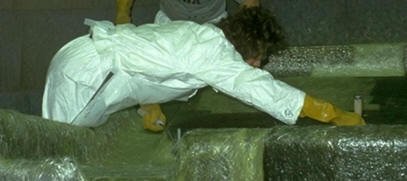 |
| Too far away to see properly |
This excessively long reach makes it difficult to see, in addition to back strain and ability to make accurate hand movements. The consequences include defects, wasted time, and injury to the back and shoulder. The photos at the top of this page show equivalent problems.
These shortcomings are all too common. The exact solution depends upon the product and task, but for ideas and options see: free-standing fixtures, bench fixtures, work platforms, height adjustment,slanted surfaces, and surface dimensions.
Note that problems like difficulty in seeing are easy for humans to become accustomed to and very quickly become part of the job. To overcome this barrier, it can be helpful to (a) review videotapes and photographs of people working, and (b) systematically observe work areas using a simple ergonomics checklist. Usually once identified, they become strikingly obvious.
Fixtures
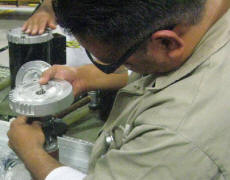 |
| Fixture design constricts view |
Many bench fixtures put products in an orientation that constricts a good view of the work that is being performed. See fixtures for ideas and options for improvement.
Guides and visual markers
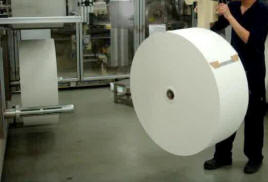 |
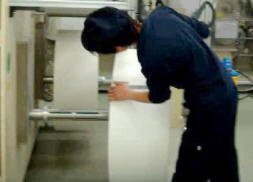 |
| Loading paper roll on machine spindle | The hole and spindle are hidden from view |
The employee loading this roll of paper onto a machine had difficulty matching the hole with the spindle.
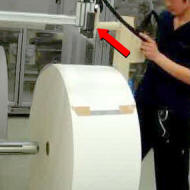 |
 |
| Mark machine at arrow as aiming point | Hoist hook has fixed length |
There are several options for creating guides to help locate the hole onto the spindle, such as a mirror or a V-shaped stand under the spindle. However, a cost-free technique is to mark the machine at a point (arrow) where the top bar of the hoist hook lines up when the roll is in position. Thus, the employee simply aims for the mark — when the top bar is aligned, the hole is aligned.
Simple marks and guides like this can overcome hidden views in a surprising number of instances.
Layout and location
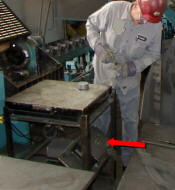 |
| Read-out display in poor location |
In this photo, a read-out display is located under a table. Whenever the employee needs to check a reading, he needs to stop productive work and crane his neck to see. Furthermore, he tends to read the numbers upside down, which increases the risk for error. Relocating the display would be a very easy improvement. The problems in this case are fairly minor, but equivalent issues in other operations can create significant problems.
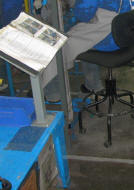 |
 |
| Holder for operations manual | Music stand as document holder |
A common example of poor location for items that need to be seen is placement of written documents, such as operations manuals. Too often, these documents are simply placed on a horizontal bench some distance from where the work is performed, thus causing employees to walk back and forth and bend down to check requirements. Industrial strength copy holders usually are needed.
Mirrors
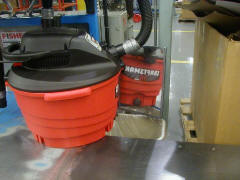 |
 |
| Mirror at inspection station | Non-reversed mirror (www.mcmaster.com) |
Mirrors are commonly used to see hidden portions of an object, in particular the underside or far side. A common application is inspection, where the task is simply to check for the existence or not of labels or components. A type of mirror designed especially for this purpose is a “non-reversed” mirror for reading numbers and words.
Visibility
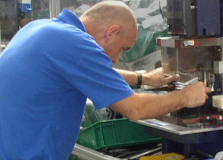 |
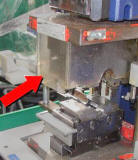 |
| Plastic safety guard too scratched and dirty to see | |
The problem in these photos is a scratched and dirty plastic machine guard, which required extra time and a bent neck to see the part and fixture. Manufacturing plants can be dusty and it is not uncommon for signs, computer screens, and dials to become obscured after a time.
Anything that must be seen must be clear. Items should be distinguishable from the background and there should be no obstructions. Size of numbers or lettering in signs, gauges, or displays should be appropriate for the distance from which it is to be observed. (See cognitive ergonomics.)
